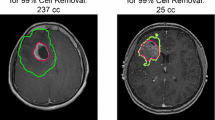Abstract
The standard treatment for newly diagnosed glioblastoma multiforme is surgical resection followed by radiotherapy and chemotherapy. Most studies on these treatments are retrospective clinical data analysis. To integrate these studies, a mathematical model is developed. The model predicts the survival time of patients who undergo resection, radiation, and chemotherapy with different protocols.








Similar content being viewed by others
References
Albert FK, Forsting M, Sartor K, Adams HP, Kunze S (1994) Early postoperative magnetic resonance imaging after resection of malignant glioma: objective evaluation of residual tumor and its influence on regrowth and prognosis. Neurosurgery 34:45–61
Lacroix M, Abi-Said D, Fourney DR, Gokaslan ZL, Shi W, DeMonte F et al (2001) A multivariate analysis of 416 patients with glioblastoma mltiforme: prognosis, extent of resection, and survival. J Neurosurg. 95:190–198
Stupp S, Mason WP, Bent MJ et al (2005) Radiotherapy plus concomitant and adjuvant temozolomide for glioblastoma. N Engl J Med 352:987–996
Friedman A, Tian JP, Fulci G, Chiocca EA, Wang J (2006) Glioma virotherapy: effects of innate immune suppression and increased viral replication capacity. Cancer Res 66:2314–2319
O’Donoghue JA, Bardies M, Wheldon TE (1995) Relationships between tumor size and curability for uniformly targeted therapy with beta-emitting radionuclides. J Nucl Med 36:1902–1909
Rew DA, Wilso GD (2000) Cell production rate in human tissues and tumours and their significance. Part II: clinical data. Eur J Surg Oncol 26:405–417
Fulci G, Breymann L, Gianni D, Kurozomi K, Rhee SS, Yu J et al (2006) Cyclophospharnide enhances glioma virotherapy by inhibiting innate immune responses. Pro Nat Acad Sci 103:12873–12878
Fowler JF (1991) The phantom of tumor treatment—continually rapid proliferation unmasked. Radiother Oncol 22:156–158
Stummer W, Reuler HJ, Meinel T et al (2008) Extend of resection and survival in glioblastoma multiforme: identification and adjustment for bias, Neurosurgery 62:1–11
Werner-Wasik M, Scott CB, Nelson DF et al (1996) Final report of a phase I/II trial of hyperfractionated and accelerated hyperfractionated radiation therapy with carmustine for adults with supratentorial malignant gliomas: radiation therapy oncology group study 83–02. Cancer 77:1535–1543
Chang EL, Yi W, Allen PK, et al (2003) Hypofractionated radiotherapy for elderly or younger low-performance status glioblastoma patients: outcome and prognostic factors, Int J Radiat Oncol Biol Phys 56:519–528
Sultanem K, Patrocinio H, Lambert C et al (2004) The use of hypofractionated intensity-modulated irradiation in the treatment of glioblastoma multiforme: preliminary results of a prospective trial. Int J Radiat Oncol Biol Phys 58:247–252
Floyd NS, Woo SY, Teh BS (2004) Hypofractionated intensity-modulated radiotherapy for primary glioblastoma multiforme. Int J Radiat Oncol 58:721–726
Gorlia T, van den Bent MJ, Hegi ME et al (2008) Nomogram for predicting survival of patients with newly diagnosed glioblastoma: prognostic factor analysis of EORTC and NCIC trial 26981/CE.3. http://Oncology.Lancet.com, 9:29–38
Acknowledgements
This work is partially supported by the National Science Foundation upon agreement No. 0112050. The first author is also supported by new faculty startup fund from the College of William and Mary, and Suzann Mathews Summer Research Grant.
Author information
Authors and Affiliations
Corresponding author
Appendix
Appendix
Consider a radially symmetrical tumor and denote by r the distance from a point to the origin. We denote the boundary of the tumor by r = R(t). Set
The proliferation and removal of cells cause a movement of cells within the tumor, with a convection term, for tumor cells x, in the form \(\frac{1}{r}\frac{\partial}{\partial r}[r^{2}u(r,t)x(r,t)]\), where u(r,t) is the radial velocity; u(R *,t) = 0 since the tumor does not grow inward. By mass conservation law,
Similarly,
We assume that the total density of tumor and necrotic cells is constant through the tumor, that is, x(r,t) + y(r,t) = const = θ, and θ = 106/mm3 [5]. By adding Eqs. (1) and (2) together, we obtain an equation for the radial velocity:
The tumor radius evolves according to
We assume that,
that is, initially 90% of cells are tumor cells, and 10% are necrotic cells.
We need to solve Eqs. (1), (3) in R * ≤ r ≤ R(t) with the initial condition (5) and with the tumor growth condition (4).
The above model does not include radiotherapy and chemotherapy. If the standard radiotherapy is administered over a period of 6 weeks during the time period 6 ≤ t ≤ 12 and the temozolomide is given for 40 weeks, Eqs. (1) and (2) are replaced by
By adding the two equations, we obtain the same Eq. (3), as before, for the velocity u(r,t).
Figures (1)–(7) are based on solving Eqs. (6) and (3) in R * ≤ r ≤ R(t) together with (4)and (5).
Rights and permissions
About this article
Cite this article
Tian, J.P., Friedman, A., Wang, J. et al. Modeling the effects of resection, radiation and chemotherapy in glioblastoma. J Neurooncol 91, 287–293 (2009). https://doi.org/10.1007/s11060-008-9710-6
Received:
Accepted:
Published:
Issue Date:
DOI: https://doi.org/10.1007/s11060-008-9710-6




